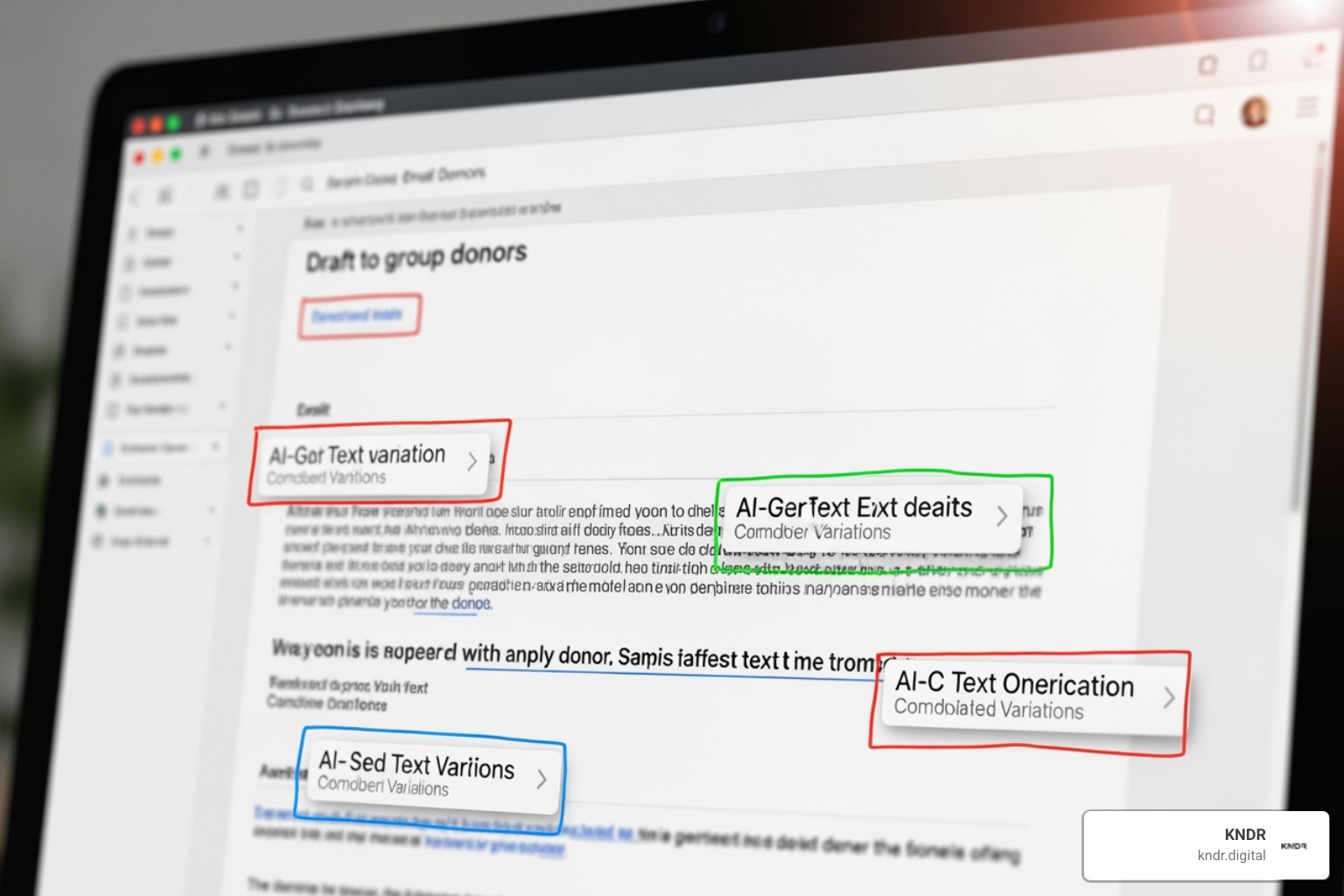From Algorithms to Altruism – Mastering AI Nonprofit Fundraising

Revolutionizing Generosity: Your Guide to AI Nonprofit Fundraising
The AI Revolution in Philanthropy: What is AI Fundraising?
Have you ever wondered what "artificial intelligence" really means? At its core, AI is simply about creating "intelligent machines," as computer-science pioneer John McCarthy once put it. Think of it as teaching computers to learn from experience, much like humans do.
When we talk about AI nonprofit fundraising, we apply that idea directly to giving. Smart algorithms help us secure donations, nurture relationships, and run campaigns far more efficiently.
The beauty of AI is that it improves human work, not replaces it. Picture a super-smart assistant that handles repetitive, data-heavy tasks so you can focus on building genuine connections.
Understanding the Technology: Key Types of AI
- Machine Learning (ML) predicts behavior. It answers WHO to contact, WHEN, and HOW MUCH they might give.
- Large Language Models (LLMs), the engines behind tools like ChatGPT, generate text. They help decide WHAT to say.
Why It Matters Now
Data is everywhere, computers are powerful, and donors expect personal, timely outreach. Yet a 2024 Stanford study shows 66% of nonprofits use some AI, but 78% lack clear policies. By leveraging AI responsibly, organizations of any size can gain efficiencies once reserved for huge teams.
Key Applications: How AI Is Reshaping Fundraising Operations
AI is no longer science-fiction; it is an everyday helper that boosts revenue and deepens relationships.
1. Prospect Research & Identification
Algorithms scan hundreds of data points to spot high-capacity prospects and assign predictive scores. The result? Up to an 85 % lift in appeal response rates and a 20 % jump in average gift size.
The Complete Guide to AI-Powered Donor Segmentation
2. Hyper-Personalized Engagement

LLMs draft individualized emails, social posts, and thank-you notes in minutes. One organization saw a staggering 1,994 % surge in monthly-donor conversions after adopting AI-custom messages.
Implementing AI for Donor Retention: The Complete Playbook
3. Campaign Optimization & Revenue Growth
• Smart gift-amount suggestions add 10-15 % more revenue.
• Dynamic donation forms learn what converts best; 87 % of donors opt to cover fees when prompted intelligently.
• Fraud-detection models block nearly 99 % of bad transactions while minimizing false positives.
• Intelligent payment-retry logic can double recurring-gift retention.
More about digital fundraising strategies
4. Faster Grant Writing & Reporting
AI quickly matches opportunities, drafts sections, and summarizes impact data—cutting proposal time by two-thirds. Automated dashboards turn spreadsheets into clear visuals, freeing staff for relationship-building.
More about data-driven fundraising
Navigating the New Frontier: Ethics and Risks in AI Fundraising
With great power comes great responsibility, and AI nonprofit fundraising is no exception. Trust is the foundation of everything we do in the nonprofit world, and any AI implementation must strengthen, not compromise, that trust.
Here's a sobering reality: 78% of nonprofits lack an AI usage policy. This means most organizations are flying blind when it comes to responsible AI use.

Data Privacy and Security
Your donors trust you with their personal information. That trust is sacred, and AI doesn't change that responsibility.
Donor consent should be at the heart of everything you do. Be upfront about how you'll use their data, especially if it's going to train AI systems. Give donors clear explanations about what you're doing and why it helps your mission.
Transparency matters more than ever. Donors should know if AI is helping personalize their communications. They should also have the right to opt-out if they're not comfortable with AI-powered approaches.
Protecting sensitive information means choosing AI vendors carefully, implementing strong security measures, and regularly auditing your data practices.
Algorithmic Bias and Equity
AI systems can perpetuate and amplify existing biases. If your historical donor data shows patterns that favor certain demographics, your AI might overlook high-potential donors from underrepresented communities.
Ensuring fair and inclusive models requires ongoing vigilance. Use representative data whenever possible, regularly audit your AI systems for biased outcomes, and always maintain human oversight.
Maintaining the Human Touch
The biggest risk with AI isn't that it will take over fundraising jobs—it's that we might lose the genuine human connections that make philanthropy so powerful.
Avoiding over-automation is crucial. Use AI to handle repetitive tasks so your team can focus on what humans do best: building relationships.
The goal is to free up time for meaningful connection. Let AI crunch the numbers while you focus on sharing your passion and building trust. More info about donor relationship management.
Accountability and Transparency
Explainable AI (XAI) should be your standard. Choose AI tools that provide clear explanations for their recommendations.
Establishing responsibility for AI outputs is non-negotiable. Your human team remains accountable for every decision made and every communication sent, even if AI helped create it.
The key is finding the sweet spot where AI improves your work without compromising the values that define your organization. Learn more about Responsible AI for nonprofits.
Your Roadmap to AI Integration: A Practical Step-by-Step Guide
You don't need a massive overhaul to start. Pick one pain point, solve it, and expand from there.
Step 1: Assess Needs & Set Goals
Identify bottlenecks—prospect research, donor retention, admin overload—and define success metrics.
Step 2: Choose the Right Tools
Focus on function, not flashy features. Key categories include:
- Prospect research & predictive analytics platforms
- Generative content tools for marketing
- CRM systems with built-in AI insights
- Workflow automation and productivity add-ons
Ensure any tool integrates with current systems, meets strict security standards, and offers solid support.
Step 3: Draft an AI Usage Policy
Create guidelines covering donor privacy, bias monitoring, data handling, and mandatory human oversight.
Step 4: Implement & Train
Roll out in phases, provide hands-on training, and foster a culture of experimentation. Emphasize that AI augments staff rather than replaces them.
Step 5: Monitor, Measure, Iterate
Track your KPIs, collect feedback, and refine your approach continuously. For deeper support, explore our nonprofit automation agency.
Frequently Asked Questions about AI Nonprofit Fundraising
Is AI too expensive for small nonprofits?
Not at all! Many affordable—and even free—AI tools are available right now. Google for Nonprofits offers fantastic free tools, including AI-powered features. Many existing CRM platforms are integrating AI features directly into their systems.
It's about focusing on return on investment (ROI). Even a modest 10-15% increase in revenue from AI-suggested gift amounts quickly justifies the investment. Find more resources at Google for Nonprofits.
Will AI replace fundraising jobs?
AI will augment jobs, not eliminate them. Think of AI as your super-smart assistant that handles repetitive, data-intensive tasks, freeing your team for high-value activities like building relationships and strategic planning.
AI will likely create new roles in the nonprofit sector as our work evolves, such as AI ethics officers or data analysts specializing in AI.
How do we ensure our donor data is safe when using AI?
Thoroughly vet any AI vendor you consider. Ask about their data security measures, encryption, and certifications. Establish robust internal data governance policies for how donor data is collected, stored, and used.
Practice transparency with your donors about how their data is used. Offer clear opt-out options and explain how AI helps you serve your mission more effectively.
Conclusion: The Future of Fundraising is Intelligent and Human-Centered
The journey into AI nonprofit fundraising isn't just about adopting shiny new technology. It's about embracing a smarter, more efficient way to serve our missions and create lasting change in the world.
Throughout this guide, we've explored how AI can transform every corner of our work. From identifying high-potential donors with laser precision to personalizing every message at scale, AI helps us work smarter, not harder. We've seen how it can optimize campaigns for maximum revenue while streamlining those tedious administrative tasks that eat up so much of our valuable time.
But here's what excites me most: AI isn't replacing the heart of nonprofit work. Instead, it's amplifying it. When we combine AI's incredible efficiency with our natural human empathy, creativity, and passion, something magical happens. We can build deeper connections with our supporters, drive greater impact, and ensure our organizations continue making a profound difference.
Think about it this way: AI handles the heavy lifting so we can focus on what we do best – the meaningful conversations, the strategic thinking, and the genuine relationship-building that donors crave. It's like having a brilliant assistant who never gets tired, never makes calculation errors, and always remembers every detail about every donor.
The "generosity crisis" is real, but it's not impossible. With AI as our ally, we can rise to meet evolving donor expectations while staying true to our core values. We can be more responsive, more personal, and more effective than ever before.
At KNDR, we've seen how AI-driven systems can transform nonprofit fundraising. Our results-based model reflects our confidence in these tools – we promise 800+ donations in 45 days or no payment because we know what's possible when AI and human expertise work together. We believe in streamlining fundraising with advanced automation and holistic digital strategies, so you can focus on what truly matters: changing lives.
The future of fundraising is here, and it's both intelligent and profoundly human-centered. It respects our donors, empowers our teams, and amplifies our impact. Most importantly, it helps us build the sustainable funding we need to tackle the world's biggest challenges.
Ready to step into this future? Let's accept it together.
Ready to master AI fundraising? Check out our services and guarantee your results.


